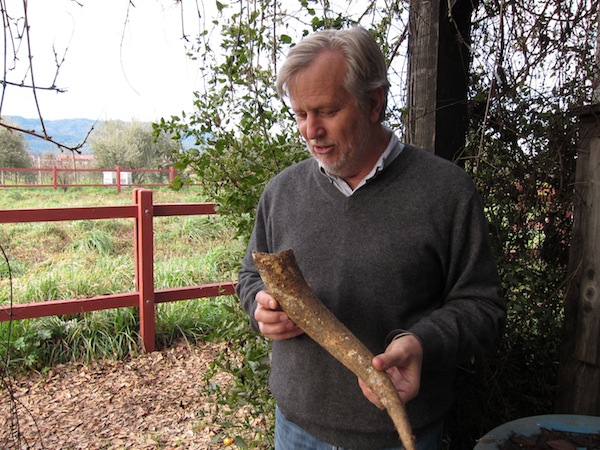Domaine Leflaive Mâcon-Verzé and lemon sage pork loin
There are many skeptics and wine geeks who do not quite see the value of some of Rudolph Steiner’s original formulas for enhancing the life of vineyard soil; such as “fermenting” cow manure in cow horns, then burying them over winter, and applying them as tea sprays in the spring (other applications are derived from ground quartz packed with rain water in cow’s horns, and flower heads of chamomile, stinging nettle, dandelion, valerian and yarrow).
But if you asked longtime winemakers such as Mendocino Wine Company’s Paul Dolan, it is not a question of leaps of faith, it is the fact that these preparations do, indeed, work; reportedly, more effectively than other organic formulations, and certainly far better than synthetic fertilizers.
What is even more sobering is the fact that some of our greatest, most coveted (and expensive) wines in the world – like that of France’s Domaine de la Romanée-Conti and Zind-Humbrecht, and Quintessa and Rubicon Estate in Napa Valley – are products of biodynamic agriculture. In California alone, according to Demeter USA, there now is a total of 38 certified biodynamic vineyards (up from twelve in 2003), with another half-dozen in transition.
But if you’d like a visual explanation of why biodynamics work, please take the time to view this gorgeous film narrated by Anne-Claude Leflaive, the agricultural director of the famed Domaine Leflaive in France’s Burgundy region, called A Path to Follow.
My take on Domaine Leflaive? Preservation of the health of the family properties for future generations is reason enough to practice biodynamie, for all its holistic, even spiritual ramifications.
Second reason-enough: It shows in the wine. The 2006 Domaine Leflaive Mâcon-Verzé (about $32), for instance, is a near-perfect Mâcon. Wines from France’s Mâcon, mind you, are usually pretty simple, straightforward, medium-full bodied dry whites, vinified from the Chardonnay grape. Leflaive’s Mâcon is medium-full bodied, and it is dry and pretty much Chardonnay-ish.
But after that, the wine goes off the charts: a nose that starts with lemon drops and then quickly transitions into honeyed apples, a dollop of vanilla, then whiffs of chalky stone followed by nuanced yet distinctive notes of licorice; and then on the palate, flavors of ripe apples and stony minerals lightened by a fresh lemony crispness, and smoothed over by an almost luxurious viscosity. In other words, wow.
What is the perfect Mâcon food? There’s a touch of lemon and a silken viscosity in the Leflaive; and so, yes, filets of white fish in a lightly lemoned butter sauce makes perfect, if predictable, sense. But the flesh and complexity of Leflaive’s Mâcon also make it perfectly suitable for a slightly fattier “other” white meat, like veal (or flattened pork tenderloin) alla piccata, or a whole loin of pork seasoned with a Chardonnay-friendly herb like basil, sage, dill or tarragon.
In this recipe, for pork loin with lemon and sage, I wouldn’t stop with taking the roast out of the oven. To bind the dish closer to the wine, I’d remove and set the loin aside, place the roasting pan on the stove, turn up the burner and deglaze with white wine and light squeeze of lemon; then turn down the heat and whisk in a square of unsalted butter, served forth in a gooseneck.






Comments
Post a Comment